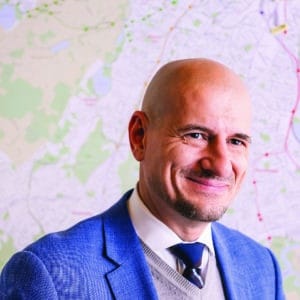Jim Grossmann
Partner, RISE Together
Age: 48
Industry experience: 30 years
In less than four years, Boston-based RISE Together has emerged as a prolific developer of multifamily and mixed-use projects. A former executive at construction manager Suffolk, Jim Grossmann met RISE Together co-founder Herby Duverné over a decade ago when he was participating in a Suffolk-sponsored subcontractor development program. Today, their company has 600 apartments under construction and another 800 in its development pipeline, including a 42-unit conversion of a former Haverhill office building. An East Boston native, Grossmann got his introduction to development at age 18 when he began working as a union carpenter while attending night school to study accounting.
Q: How did RISE Together find an adaptive reuse opportunity for apartments in downtown Haverhill, and what’s the latest timeline for completion of 86 Essex St.?
A: The opportunity came off-market from the building manager. We were finishing up another project here in Boston, and they let us know they had a client in Haverhill with an office asset. We met with the owner and negotiated the deal. The building is right next to the commuter rail stop and there was a ton of infrastructure that made it successful. Haverhill has these beautiful brick buildings that had become offices and today are turning into multifamily. The completion is right around April and we’re in interior fitouts. On the ground floor, we have 2,000 square feet of retail space and we hadn’t even started to market the space. We picked up a lease for a wine-and-cheese retailer.
Q: How does RISE Together rank the short-term prospects for the various asset categories?
A: We are mostly multi-unit residential, with a few projects that have a lab component. I don’t think it’s a surprise to anyone that the lab and office class really seems to be challenged from a financing perspective. We believe demand will be there in the long term, but in the short term, getting those projects [financed] is tough.
On the multifamily side, we have 1,400 units in the pipeline and 800 are podium-style wood-frame buildings. The neighborhood becomes the amenity. These are a much more stable outcome because of the cost escalation in high-rises. What is happening in high-rise multi-unit residential work is the workforce that completes that type of work was primarily building this lab boom. There wasn’t a depth of subcontractors doing high-rise work, and that drove costs along with inflation in steel and concrete and high-performing facades.
Q: Why has there been such a recent uptick in Charlestown development activity, including major proposals by RISE Together, The Fallon Co., The Flatley Co. and Fulcrum Global Investors?
A: It feels like people just discovered the Sullivan Square area, but the reality is that the Boston 2030 plan had called it out as a great potential development site. The interest really started to pick up with a commitment around infrastructure: Redoing Rutherford Avenue makes that viable, and the geometries of those sites lend themselves to lab really well. And geographically, it’s kind of the missing link coming from Cambridge to Somerville. There was kind of a hole in the donut and that’s what people recognized and drove a lot of developers to Sullivan Square.
Q: How is RISE Together responding to the Boston Planning & Development Agency’s request that Charlestown developers think collectively about public benefits?
A: They have been really proactive. They are going through a planning effort, PLAN: Charlestown, and we developers are getting great feedback with the community. Arthur Jemison and his team have had several meetings with all four developers, talking about what are good proposals for the four of us to have in common to have a better mitigation strategy about transit supplementation such as a shuttle, and that is picking up momentum. There are sections within Charlestown that could use supplementation, and shuttles to Kendall Square and North Station.
Q: How does RISE Together decide the optimal multifamily component in a large mixed-use project?
A: We start with geometry because multi-unit residential has a very different footprint than lab or industrial. You look at the sites you control and the best use. We’re a big believer that multi-unit residential creates a neighborhood. Sullivan Square could use some activation. And lastly, marketability. We know multi-unit is in demand and in need.
Q: RISE Together recently received approval for a lab tower near Wellington Circle. What’s the potential for air rights development controlled by the city of Medford on the Wellington MBTA station property?
A: Wellington is a great area: great land and it backs up to the waterfront. It’s a little unpolished at this moment, but it has great access to transit and something fantastic is going to happen there. There is a lot of ground plane [at the MBTA property]. While they’re air rights, you’re really building the vast majority of that not over train infrastructure but over land. That makes it economically viable. We have assembled a team and are putting a master plan together.
Grossmann’s Five Favorite Books
- “Team of Teams” by Gen. Stanley McChrystal
- “Turning Business into a Force For Good” by Barry Wanger
- “Thinking in Systems” by Donella H. Meadows
- “Am I Being Too Subtle? The Adventures of a Business Maverick” by Sam Zell
- “The Innovator’s Dilemma” by Clayton Christensen




 |
| 


